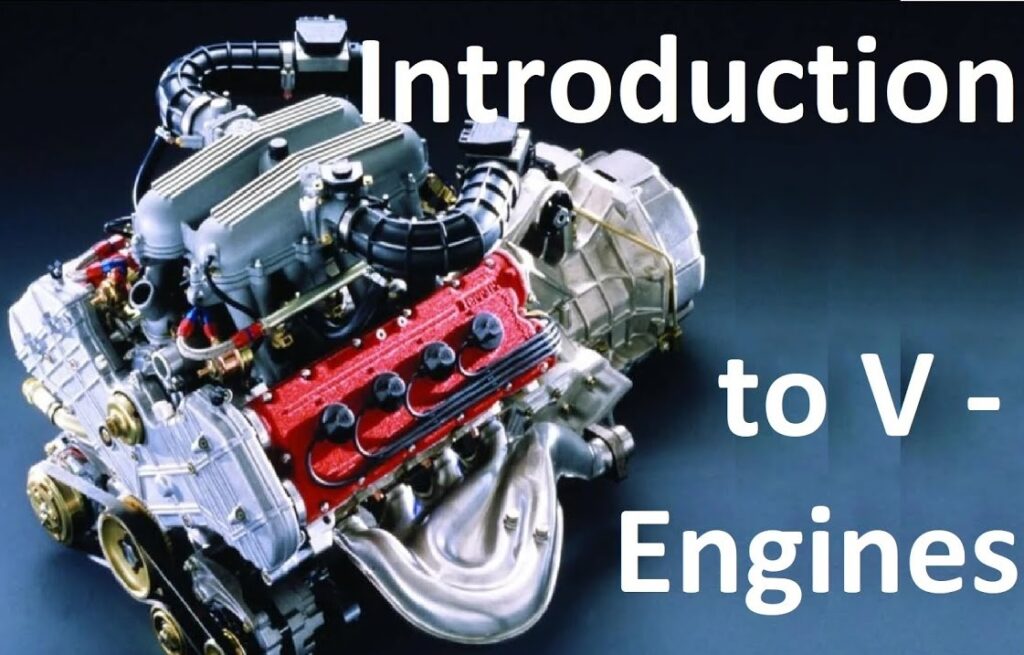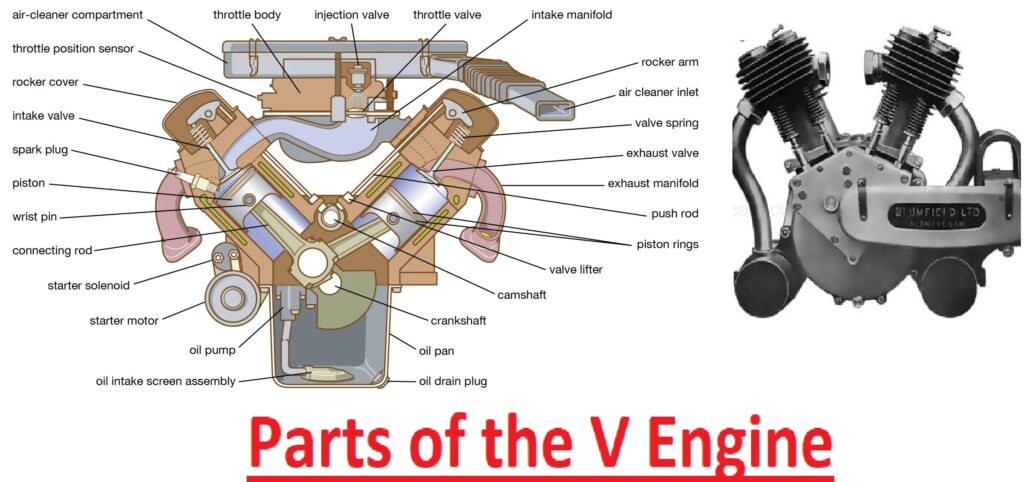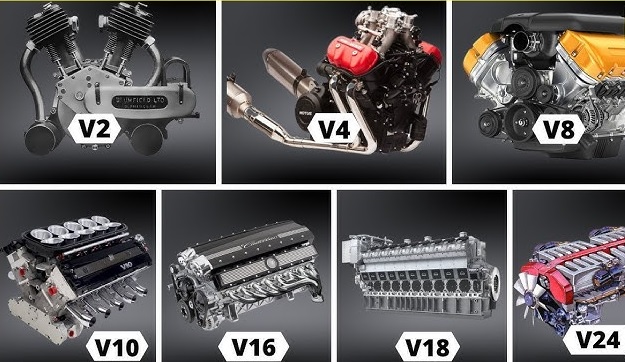The V engine is a commonly used engine that comes with cylinders in a V shape, and it uses an even number of cylinders. This engine is configured in a vertical design and comes with 6, 8, 10, or 12 cylinders. The V design helps to reduce crankshaft length and cover low areas and also generates torque with low RPM compared to other types.
In this we will cover detailed features for the V engine and related factors about the V engine. So let’s get started with the introduction to the V engine.
What is a V Engine?
- V engine, known as a Vee engine, that is commonly used for internal combustion engines. It has two cylinder banks, which have the same number of cylinders as in one bank, that configure the crankshaft.
- Cylinder banks are configured with each other at an angle, resulting in a V-like design when we observe from the engine’s front side.
- V engine comes with a small length compared to an inline engine.
- Some types of V engines are V6, V8, and V12, which come with 6, 8, or 12 cylinders, respectively.
Characteristics of the V engine
Read Also How to Read Tyre Size?
- V-engines are short in length with a larger width than other inline engine types. In this way the number of cylinders increases in the engine.
- The length difference between a V-twin and a straight-twin engine can be less, but a V8 engine is shorter than a straight engine.
- V-engine is also narrower than a flat engine, also larger in size, and has a high central mass.
- • The V angle in cylinder banks changes. Some engines have a 180-degree V angle, like Ferrari V12 engines.
- The 1922 to 1976 Lancia V4 engine and the 1991–present Volkswagen VR6 engine use V-angles of about 10 degrees. This uses one cylinder head for both cylinder banks. The
- • The engine balance of a V12 engine is primary and secondary.
- An engine that has fewer cylinders, engine balance based on firing interval, crankshaft weight, and the existence of balance shafts.
- A V-type engine comes with two rows of cylinders that make 60 or 90 degrees in two banks. The V8 engine comes with 8 cylinders, normally at a 90-degree angle, and some 6-cylinder aviation engines come horizontal, opposite to the cylinder.
Parts of the V Engine
Main parts of v engine are as
- Exhaust valve
- Cylinder head
- Piston
- Piston rings
- Push rod
- Crankcases
- Cylinder liner
- Camshaft
- Injector rocker arm
- Injector control shaft
- Injector rack
- Fuel Injector
- Spark plug
- Connecting rod
- Starter motor
- Water inlet jumper and manifold
- Crankshaft
- Crankshaft counterweight
- Piston cooling oil pipe
- Oil pan and oil level gauge
- Air cleaner
- Engine manifold
V Engine Working
- A V engine works like a 4-stroke engine, while a V engine cylinder gets air and fuel with a chamber. after getting air compressed and ignited
- Due to combustion in a closed and compressed chamber, high pressures are produced. That pressure is in the form of force applied to the piston, and it moves downwards.
- The piston then moves up and releases gas that has accumulated in the form of pressure. All processes occur in a cyclical sequence, causing the crankshaft of the engine to rotate in a circular motion.
The cycle started again for cylinders for a constant power supply.
Read Also How to Rev a Car, Features, Working,
Types of v engines
V comes in different types, and the normally used types are V2, V4, V6, V8, V10, and V12 engines. each explained here in detail
V2 Engine
- The V2 engine, called the V-twin cylinder engine, comes with two cylinders configured in a V design. This engine was first used in 1889 in Daimler Strahlradwagen cars.
- its small size, the V2 engine used in motorcycles, it is also part of cars and racing vehicles.
- It provides a good power-to-weight ratio. either has a compact design, so it is used for high-performance applications.
V4 engine
- The V4 engine rare design of the vehicle is also part of the sports car. It has 4 cylinders that are connected in a V design at a 180-degree angle.
- The V4 engine has good balance with a compact design and working. Its complex design and limited features make it rare.
V6 engine
- V6 engine: a famous type of advanced vehicle, like SUVs, pickup trucks, and sedans.
- It comes with 6 cylinders at a 60-degree angle, giving good balance for design and power efficiency.
- The V6 engine is part of both diesel and gasoline engines and is used for different applications.
- V6 engines have higher fuel efficiency than V8 and V12 engines, so they are used for modern vehicles.
V8 engine
- V8 engine is part of luxury cars where high performance is needed. It has 8 cylinders configured in two banks, each of which has 4 at a 90-degree angle. The V8 engine gives rotational power and mechanical power, so it is used for pickup trucks and military cars.
- It has good torque, acceleration, and engine sound that we love.
- V8 engine used in 1903, according to V2 engine. The V8 engine comes with 8 cylinder chambers and 2 sets of 4-cylinder chambers configured at a 90-degree angle through a crankshaft.
V10 engine
- V10 engine is preferred in sports cars and racing cars due to raw power. It has two cylinders connected at 90 degrees, and it generates high power and also high revolutions per minute (RPM), giving exceptional performance.
- This engine was first made in 1965 and was the first petrol engine made with the Dodge Viper in 1991.
V12 engine
- The V12 engine is used in luxury cars and military vehicles. that has 12 cylinders at a 60-degree angle, giving high power and torque. The V12 engine is used in branded cars like Rolls-Royce and Ferrari.
- It’s used for high-performance vehicles since it provides high power with smooth operation.
V16 Engine
- The V16, called a piston engine, has two banks with eight cylinders connected in a V design over a single crankshaft.
- This engine is not common like V8 and V12 and comes with a 45-degree bank angle. A V16 engine is part of a marine craft and a power generator.
V18 Engine
- This engine comes with 2 banks with 9 cylinders in a V design, over one crankshaft. The V18 engine used a larger diesel engine working at low speeds.
V20 Engine
- The V20 engine is also a piston engine having 2 banks with 10 cylinders in a V design over the crankshaft.
- This engine is used for haul trucks, generators
V22 Engine
- The V22 engine has a V-shaped design and two banks of 22 cylinders. That design provides a compact design with high power output.
V24 Engine
-
- The V24 engine has two banks with 12 cylinders in a V design over one crankshaft.
- v24 engine used for the M.C.72 aircraft, 1930
Difference Between V ENGINE and INLINE ENGINE
V engine
- The main difference is their cylinders; an inline engine comes with cylinders in a single line, and a V engine has cylinders in 2 lines, making a V design.
- •V engine provides high efficiency and compact design. V-shaped construction provides a smooth design and minimizes noises and vibrations.
- V engines are used for high-performance vehicles, like sports cars and racing cars, since they provide high power and uniform working.
- The compact layout of V engines makes them good for engine where space is limited, like modern cars, racing cars
Inline engine
- •An inline engine is simple in design and has a low-cost design, and easy to maintain. The simple design uses few parts and a less complex design that makes for low manufacturing costs and easy maintenance.
- It is used for small vehicles and provides a lower-cost option than high-performance.
- The V engine has high efficiency and power and a complicated design, but it has a high cost.
- Inline engine: simple design, low cost, and easy maintenance.
- But its performance is not higher than a V engine. For military vehicles and railway engines, and where high power is needed, V engines are used.
V engine maintenance
- For longer working and high-performance maintenance of the engine, it is important. If we do regular maintenance, like filter replacement and oil changes, it helps the engine to work uniformly. V engine complex design, rather than an inline engine.
- V-engine comes with a complicated design and uses special tools for maintenance. Complex design makes it costly and difficult.
- Regular maintenance minimizes errors and increases the working life of the engine.
Advantages of V-Type Engine
- It is small in size with an 8-cylinder engine, and the low position of the bonnet provides good aerodynamics.
- It provides good balance and controls vibrations.
- Its smooth operation causes high-speed working.
- It is used for high-end sports cars.
Disadvantages
- its design is complex, make difficult to manufacture.
- cooling also includes errors of V engine design
- It is of high weight since it has different parts.
- It is more costly than other engines, which makes luxurious vehicles.
- It has low fuel efficiency.
Read AlsoWhy Are My Car Brakes Grinding?
FAQs
Define V in an engine?
- V engines come with engine cylinder designs that, connected in 2 lines, make V shapes.
Which is better, a V or W engine?
- Both have their own features. The V engine is common and has a compact design, and the W comes with more engines and provides larger power.
What makes V engines famous?
- The V-shaped design comes with more cylinders in a low area space, which causes high power output without a larger engine size. The compact design distributes weight for high-performance features.
difference between V and W engines?
- w comes with 3 cylinders that look like the mark of property of the British government.
- It is less famous compared to V engines and W engines and is smaller and larger in size than engines.
Which engine is better, inline or V?
- An inline engine has good fuel efficiency, and a V design provides good performance but uses high fuel.
Which cars have V engines?
- High-performance and luxury cars like the Mercedes-Benz S-Class, Ferrari, and Lamborghini come with V engines.
What types of V engines are there?
- • The main types of V engine are V2, V4, V6, V8, V10, and V12 engines, each of which comes with a different cylinder number and applications.
Is there a V24 engine?
- The V24 engine is not commonly used in vehicles but theoretically exists. It used larger ships or heavy machinery.
Which V engine type is the best?
- Good V engine based on applications, like sports cars; V8 or V12 engines are common types, and V6 gives good power and fuel efficiency in vehicles
Conclusion
The V engine is used for modern vehicles, and its type, V6, is part of pickup truck types, and V12 is used for luxury cars. It is also used for luxury vehicles. A V engine and its working help to operate vehicles with high performance.


